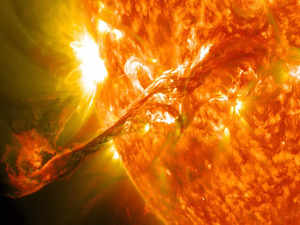Synopsis
Geomagnetic Storm is reportedly brewing and is likely to erupt on Monday. Northern Lights activity may also start during this period.
 Navbharat Times
Navbharat TimesThe Space Weather Prediction Center (SWPC) of National Oceanic and Atmospheric Administration (NOAA) has issued a moderate G2 Geomagnetic Storm Watch for Monday. There is a likelihood of moderate Northern Lights activity starting Sunday night into Monday morning, and there is potential to witness the lights as far south as southern Wisconsin and northern Nebraska.
Ongoing solar eruptions have been sending plasma towards Earth, prompting the SWPC to issue another Geomagnetic Storm Watch. This activity is leading to vibrant displays of the Northern Lights across certain parts of the US. The SWPC releases geomagnetic storm alerts to caution about potential disruptions to communication systems and spacecraft operations. During significant solar storms, widespread power outages and communication system failures are possible. Solar wind interactions with Earth‘s atmosphere create the Aurora Borealis or Northern Lights, and intense space weather events can make these lights visible at greater distances from Earth’s poles, as observed last week.
The current ongoing solar cycle is likely to peak its intensity in 2024 and can potentially impact Earth’s space weather, according to researchers at the Indian Institute of Science Education and Research (IISER), Kolkata. It is known that roughly every 11 years, the intensity of solar activity reaches its peak, which manifests as violent disturbances in space weather such as solar magnetic storms or coronal mass ejections, impacting Earth’s satellites and telecommunications.
“During intense solar storms, the Earth’s upper atmosphere expands outwards, thereby introducing friction on the low-Earth satellites. The friction can lead to a decay in the satellites’ orbits and reduce their lifetime. Thus, they are able to live in space for a much shorter time than they were originally supposed to,” Dibyendu Nandy, the study’s corresponding author and Professor of Physics and Head, Center of Excellence in Space Sciences India, IISER, Kolkata, told PTI.
The researchers also said that the most intense of these storms can cause serious damage to orbiting satellites, electric power grids and telecommunications when directed at Earth.
In their study appearing in the journal Monthly Notices of the Royal Astronomical Society Letters, the researchers discovered a new relationship to help predict the occurrence of peaks in solar cycles, which are produced by an internal dynamo mechanism, harnessing energy from plasma flows inside the Sun.
Using decades-old data archives from ground-based solar observatories worldwide, they found that the ongoing solar cycle 25 is related to the Sun’s magnetism activity, which they said manifests as sunspots cycle and recycling of the large-scale solar dipole magnetic field.
FAQs
Q1. What do we know about solar activity?
A1. Ongoing solar eruptions have been sending plasma towards Earth, prompting the SWPC to issue another Geomagnetic Storm Watch. This activity is leading to vibrant displays of the Northern Lights across certain parts of the US.
Q2. What are the impact of solar storm?
A2. The researchers also said that the most intense of these storms can cause serious damage to orbiting satellites, electric power grids and telecommunications when directed at Earth.
Disclaimer Statement: This content is authored by a 3rd party. The views expressed here are that of the respective authors/ entities and do not represent the views of Economic Times (ET). ET does not guarantee, vouch for or endorse any of its contents nor is responsible for them in any manner whatsoever. Please take all steps necessary to ascertain that any information and content provided is correct, updated, and verified. ET hereby disclaims any and all warranties, express or implied, relating to the report and any content therein.
Read More News on
(Catch all the US News, UK News, Canada News, International Breaking News Events, and Latest News Updates on The Economic Times.)
Download The Economic Times News App to get Daily International News Updates.
…moreless

